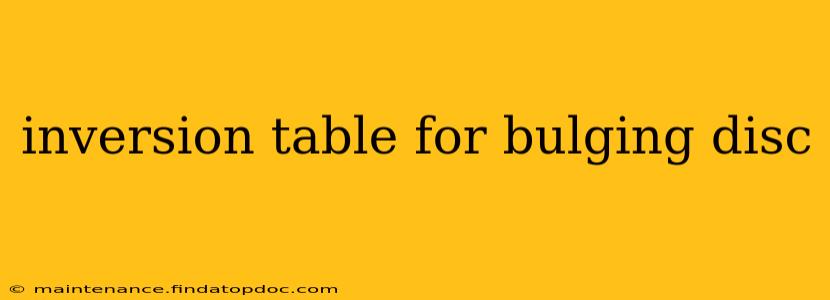A bulging disc, a common cause of lower back pain, occurs when the soft, gel-like center of an intervertebral disc pushes against the outer layer. Many individuals explore alternative therapies to manage the pain and discomfort associated with this condition, and inversion therapy is one such method. This article delves into the potential benefits, risks, and important considerations surrounding the use of an inversion table for bulging discs.
What is an Inversion Table?
An inversion table is a device that allows you to gradually invert your body, suspending you upside down at varying angles. Proponents suggest that this inversion can help decompress the spine, reducing pressure on the bulging disc and potentially alleviating pain.
Can an Inversion Table Help with a Bulging Disc?
The purported benefit of inversion therapy for bulging discs lies in its ability to create spinal decompression. By hanging upside down, gravity pulls on the spine, potentially creating space between the vertebrae. This decompression can theoretically reduce the pressure on the bulging disc, relieving pain and inflammation. However, it's crucial to understand that the scientific evidence supporting this claim is limited and mixed. While some studies suggest potential benefits, others show little to no significant improvement. More robust research is needed to definitively establish the efficacy of inversion therapy for bulging disc treatment.
How Does Inversion Therapy Work for Bulging Discs?
The mechanism behind the potential benefits is relatively straightforward. By inverting your body, the weight of your upper body pulls downwards, stretching the spine and reducing the pressure on the intervertebral discs. This decompression can potentially improve blood circulation and reduce inflammation in the affected area.
What are the potential benefits of using an inversion table for a bulging disc?
- Pain Relief: Some individuals report a reduction in back pain after using an inversion table. This is likely due to the decompression of the spine.
- Improved Flexibility and Range of Motion: Gentle stretching during inversion might improve spinal flexibility and range of motion over time.
- Reduced Muscle Spasms: The stretching and decompression may help relax tense muscles, thus reducing muscle spasms frequently associated with bulging discs.
- Improved Posture: Regular use might encourage better posture by promoting spinal alignment.
What are the potential risks of using an inversion table for a bulging disc?
- Increased Pain: For some, inversion can actually worsen pain, particularly if the inversion is too forceful or performed improperly.
- Headaches: Increased blood flow to the head during inversion can trigger headaches in some individuals.
- Eye Problems: Increased pressure in the head can also temporarily affect vision.
- Muscle Strains: Improper use or excessive inversion can strain muscles.
- Injury to the Spine: In certain cases, inversion could potentially cause further damage to the spine, especially if there are pre-existing conditions.
- High Blood Pressure: Individuals with high blood pressure should consult their doctor before using an inversion table.
Is Inversion Therapy Right for Me?
The decision of whether to use an inversion table for a bulging disc should be made in consultation with a healthcare professional. Your doctor can assess your specific condition, consider any pre-existing health issues, and advise whether inversion therapy is appropriate for you. They can also guide you on the proper techniques to minimize risks and maximize potential benefits.
Should I see a doctor before using an inversion table?
Yes, absolutely. It's essential to consult your doctor or physical therapist before beginning any inversion therapy program. They can assess your specific condition, evaluate the potential risks, and determine if it's a suitable treatment option for you. Pre-existing conditions like high blood pressure, glaucoma, heart conditions, or recent spinal surgery can make inversion therapy risky.
Are there any exercises I can do alongside inversion therapy?
While inversion therapy might offer some relief, it's not a standalone solution. Your doctor or physical therapist might recommend other therapies, including:
- Physical therapy: Exercises designed to strengthen core muscles, improve posture, and increase flexibility.
- Medication: Pain relievers or anti-inflammatory drugs to manage pain and inflammation.
- Lifestyle changes: Maintaining a healthy weight, practicing good posture, and avoiding activities that aggravate your back pain.
What are the alternatives to inversion therapy for a bulging disc?
Many effective treatments exist for bulging discs, and your doctor might recommend one or a combination of the following:
- Medication: Over-the-counter pain relievers or prescription medications.
- Physical therapy: Exercises to strengthen your core and improve flexibility.
- Epidural steroid injections: To reduce inflammation in the spine.
- Surgery: In severe cases, surgery might be necessary.
Remember, inversion therapy is not a magic bullet for bulging discs. It should be considered as one potential component of a comprehensive treatment plan guided by a healthcare professional. Always prioritize safety and consult your doctor before starting any new treatment.
